Lure color change is the most obvious thing we inshore anglers look for. While other things are more important, dialing in the right color can make a big difference in several ways.
Not long ago I went fishing in Lake Pontchartrain, and why wouldn't I?
Speckled trout are usually running this time of year, plus there was an awesome report for the area, and the wind was laying down.
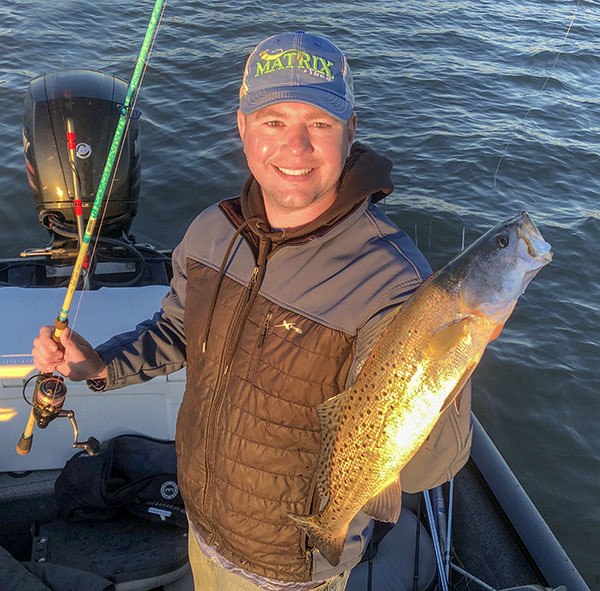
Jamie loves catching speckled trout during their spring run.
Lure Color Change For Speckled Trout
So launching the boat was a no-brainer!
Not that I'm the greatest inshore angler ever, but I do consistently catch good fish and feel strongly that this knowledge used to do it helps other anglers get similar results.
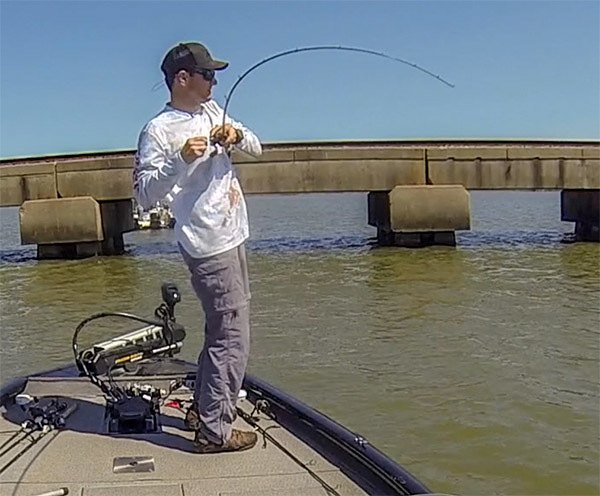
Experimenting with lure color was key to getting more quality bites.
One of the decisions made on this trip was the decision to change color, and it was made more than once.
How come? That's what we jump into next but, real quick, let's not overlook the important stuff.
What's More Important Than A Lure Color Change?
Before we go any further, it's important to point out that lure color is often given a higher priority than other things that aren't as sexy, but certainly more effective:
Anyway, I had these things dialed in and the finishing touch was this specific lure color change.
See, at the time Lake Pontchartrain was pretty dirty due to the opening of the Bonnet Carré Spillway, but this small vein of water was cleaning up and the sun shining bright.
Openings like this were common during the Freshening and made fishing challenging at times.
General Rules on Lure Color
Without going into a diatribe about every lure color and what they're useful for, it's a general rule that:
- brighter, contrasting colors are used in dirty water
- softer, more natural colors are used in cleaner water
So with that in mind, and given the prevailing conditions, it made sense to try out a more natural color.
Which Color Was Picked?
Smokin' Mullett on a Slayer, Inc. Sinister Swim Tail (S.S.T.)
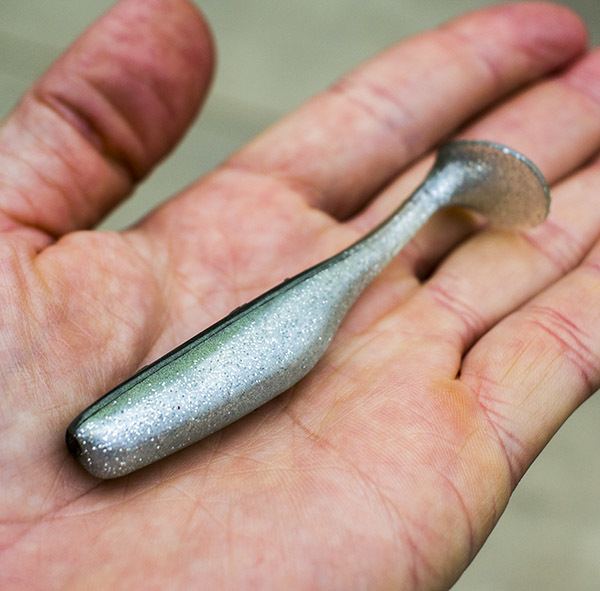
As you can see, it's a traditional 3" soft plastic featuring a slightly larger paddle tail.
Why pick this color?
This color was chosen for a couple reasons:
- I've caught fish on it before
- I felt it resembled nearby forage
The first reason is the most obvious, but I did note a number of bay anchovies and gulf menhaden (or pogies) traveling the tideline trout were being caught on.
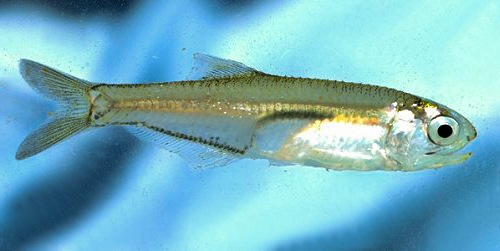
The common color scheme between the two of them is a light green back and silvery sides.
The green back and fine glitter of Smokin Mullett seemed to match this well, even though pogies may have a darker colored back at times.
Don't look into it too much!
I'm not telling you that throwing a lure that looks exactly like what fish are eating is the golden ticket to catching.
I just thought "that could be a good choice", slipped it over the jighead and began casting.
That's it.
If it didn't work, then I'd take it off and go back to what I was using before, or try something else.
That's it.
Seriously, there's no magical formula here that guarantees anything, it's simply trying and applying 3% Theory.
Besides, experimenting with a lure color change is absolutely pointless without knocking out the far more important things listed first.
Was the lure color change effective?
I feel that it was.
Fish were committing to the lure, I began catching more, and the fish were quality.
In fact, this lure color accounted for 12 of the 16 specks landed that afternoon (22 for the day total).
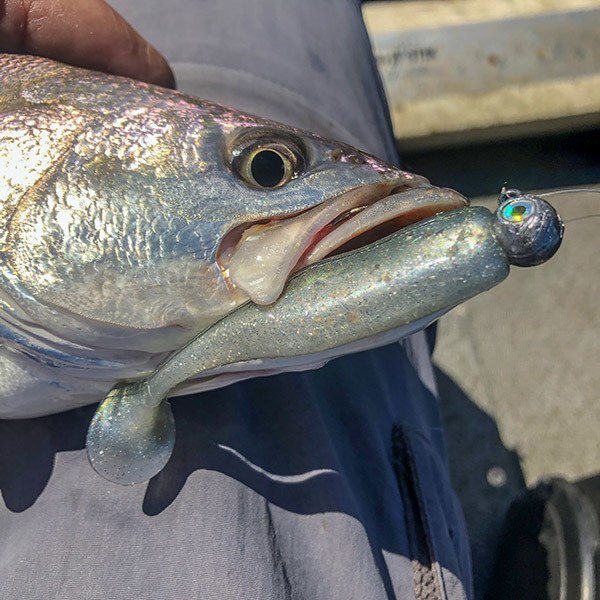
Conclusion
I feel other colors could have worked well, it's just that Smokin' Mullett is the one I picked and caught trout on.
Or maybe the trout just turned on that much more, I cannot say for certain.
It's difficult to scientifically test variables on the water due to time constraints and the fact that conditions are always changing.
But, I feel it's safe to say that the lure color change was a winning factor here, especially considering that few boats in the vicinity, if any at all, landed comparable catches, even those using live shrimp.
Want More?
While lure color is certainly something any inshore angler enjoys tinkering with, it is not as important as finding biting fish in the first place.
That and more is what I teach inside LAFB Elite, if you have an open mind and are willing to learn.

Hey Jamie, that’s a good question that all of us have asked at some point.
I’ll tell you that if there are fish at a spot, and if you are getting your bait in front of them as per the Elements of Effective Fishing, then you WILL get some kind of “play” from them in the form of bites or fish following your bait (but not committing to it).
But, like I say in the video and in this blog post, there are far more important things than dialing in lure color and I’ll let you review them.
Otherwise, swapping out color after color and not catching anything is a waste of time.
So, as long as I effectively fish the entire water column – as described in this free course – and I get no bites at all, then it means there are no fish there and I am leaving to go to my next spot.
I hope that answers your question, Jamie.
Tight lines!
How can you tell if there are simply no fish there, or you’re just using the wrong color without casting lots of colors at every stop?
Thank you very much!
Great article, Devin!
Hey Eddie, you’ve asked this before and I gave it a pretty lengthy reply, which I will re-paste here:
Eddie, I’m glad you brought this up.
Over the years I’ve also heard similar things:
– trout are scared of hardheads
– redfish get blue tails when they’re hungry
– mullet jump so they can see where they’re going
– and a lot of other stuff
And what I’ve learned is that a serious discussion cannot take place without references.
Otherwise, how do we know the information isn’t made up?
Fact of the matter is that speckled trout have an incredibly high survival rate upon being released.
How high? 74%
And that’s with live bait on a single hook, so I’m sure the hook was set slow and in the gut.
When using artificial lures, the survival rate is even higher at 97%!!!
This information comes from an 18-month study conducted in Louisiana during the 90s.
Here’s the link at LSU Sea Grant’s website.
Since you asked, in my experience, when talking about releasing trout, the “only 25% trout survive” example is used to justify keeping them.
Which is fine, but some people get a little weird when someone is totally fine and secure with their decision to release trout that they caught.
So they start citing numbers without a reference, which may have worked 20 years ago, but these days we all have super computers in our pockets, so fact checking (and having references handy) is easier to do.
It also puts us in touch with others who share our passion, just like what’s going on here, so I thank you for posting this!
Tight lines, Eddie!
true or false – I have been told when you release a speckle trout 80% of them Die.
Thanks Wayne
informative and easy to follow logic. thanks
I’m glad you asked this.
It used to be chartreuse (and I still fish with that color), but now I have a lot of confidence in Matrix Shad in Ultraviolet, which is like a pinkish off-white with silver flake.
I’ll start with that then work my way from there, based on what the fish tell me.
Hope that answers your question, thanks for commenting!
Never would’ve thought of that. Very useful.
What’s your favorite color to start with, like no matter what?
Thanks, Jeff!
Nice Video informative